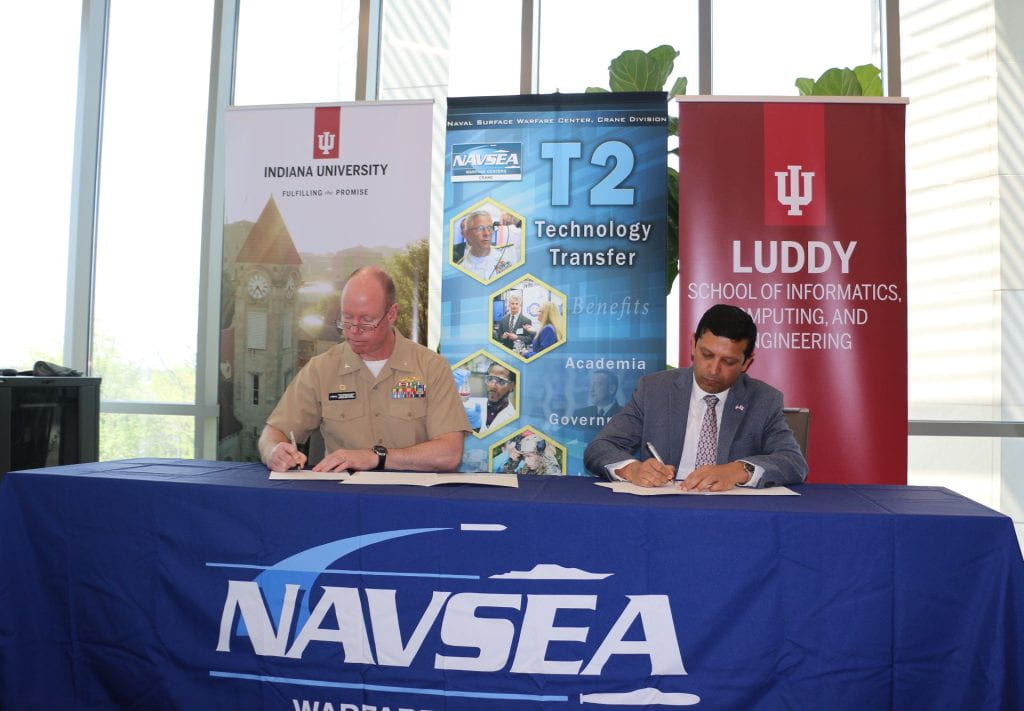Indiana University and Naval Surface Warfare Center, Crane Division, have announced an expansion of their partnership to effectively leverage IU’s educational and research assets to support the nation’s strategic defense initiatives and advance and accelerate innovative solutions to national security challenges.
At a ceremony Monday afternoon, April 24, at IU’s Luddy School of Informatics, Computing and Engineering, senior officials from IU and NSWC Crane approved an amendment to an educational partnership agreement, originally enacted in 2011, that has paired IU and Crane researchers on projects in areas of vital importance to the defense community, such as artificial intelligence, edge computing, secure microelectronics and sensor data fusion. The agreement also established a formal presence for NSWC Crane at Multidisciplinary Engineering and Sciences Hall, a 207,000-square-foot building on the IU Bloomington campus, which has recently been converted into laboratory space for IU’s Department of Intelligent Systems Engineering at the Luddy School.

IU Executive Vice President and IU Bloomington Provost Rahul Shrivastav joined Capt. Thomas (Duncan) McKay, Commanding Officer of NSWC Crane, in signing the amendment to the educational partnership agreement. With the new amendment, NSWC Crane has appointed a full-time liaison to IU to further structure the partnership between the two institutions and help facilitate collaboration on projects specific to national security innovation. In turn, IU is providing NSWC Crane with on-campus office space at the Luddy School and network connectivity.
“As IU and NSWC Crane enter an era of unprecedented potential, I’m thrilled that we are doing so in close support and alliance,” said Shrivastav. “With a liaison based on campus, we can bring together defense, academic and entrepreneurial innovators not only to solve national security problems, but to identify opportunities before challenges emerge.”
Charles Colglazier, a cybersecurity expert at NSWC and south Indiana’s representative on the National Security Innovation Network, a program office within the U.S. Department of Defense, will serve as the new liaison, working to link IU resources, including faculty and student research and innovation spaces, with emerging needs at NSWC Crane. Colglazier graduated from IU with a bachelor’s degree in physics and earned an MBA at the IU Kelley School of Business.
“This EPA renewal represents a long-term commitment from both NSWC Crane and IU to continue working together,” said Capt. McKay. “This is an expansion of an already robust partnership, and this collaboration will accelerate innovative solutions to national security challenges.”
NSWC Crane supports electronic, engineering and ordnance needs of the U.S. Navy and other military customers. It is one of Indiana’s largest high-tech employers with over 3,800 employees, of which 2,500 are scientists, engineers and technicians. NSWC Crane is the principal tenant command at Naval Support Activity Crane, the third-largest naval installation in the world, which is located approximately 40 minutes southwest of IU’s Bloomington campus.
Recent years have seen IU and NSWC Crane take major steps to pursue new collaborative efforts—in such critical areas as advanced materials, computer vision, cybersecurity, microelectronics and radiation effects—to address national defense challenges and improve Indiana’s economic competitiveness. Late last year, the two institutions re-signed a partnership intermediary agreement, initiated in 2012 and renewed in 2017, that provides NSWC Crane with an avenue to move innovative technology through the commercialization pipeline with a goal of increasing the number of licensing and startup deals for both Crane and IU.
IU and NSWC Crane also continue to explore new opportunities for collaboration that will be enabled by the recently enacted CHIPS and Science Act of 2022, which calls for a historic investment of nearly $280 billion in new funding to boost domestic research and manufacturing of semiconductors. IU was one of the first universities to support the legislation, which represents a major initiative to build a more resilient innovation and manufacturing ecosystem.
IU and NSWC Crane are also working together to ignite high-tech innovation at WestGate@Crane Technology Park, including the park’s new $84 million microelectronics campus, which is designed to power the growth of Indiana’s semiconductor industry.
NSWC Crane was an early advocate for IU’s engineering program, established in 2016, and its researchers continue to work alongside IU scientists on advanced technology and other projects related to national security. IU and NSWC Crane recently collaborated on research into innovative techniques to protect artificial intelligence and machine learning systems used by the U.S. Navy from adversarial threats. More than 20 IU undergraduate and graduate students at the Luddy School participated in the research partnership, which was enabled through the Naval Engineering Education Consortium. The consortium is working to address the Navy’s most relevant technology needs and cultivate a world-class naval engineering workforce through student-based research conducted at U.S. colleges and universities.
In late 2020, IU also launched a new Academic Accelerator with support from the National Security Innovation Network. The program, which is designed to support and advance the development of promising new technologies with potential applications in national security and defense, recently achieved two new project milestones, both of which have implications for work at NSWC Crane.
About NSWC Crane:
NSWC Crane is a naval laboratory and a field activity of Naval Sea Systems Command (NAVSEA) with mission areas in expeditionary warfare, strategic missions and electronic warfare. The warfare center is responsible for multi-domain, multi-spectral, full life cycle support of technologies and systems enhancing capability to today’s warfighter.
Leave a Reply